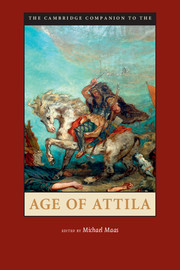
-
Select format
-
- Publisher:
- Cambridge University Press
- Publication date:
- October 2014
- September 2014
- ISBN:
- 9781139128964
- 9781107021754
- 9781107633889
- Dimensions:
- (228 x 152 mm)
- Weight & Pages:
- 0.85kg, 504 Pages
- Dimensions:
- (228 x 152 mm)
- Weight & Pages:
- 0.73kg, 528 Pages
You may already have access via personal or institutional login
Book description
This book examines the age of Attila, roughly the fifth century CE, an era in which western Eurasia experienced significant geopolitical and cultural changes. The Roman Empire collapsed in western Europe, replaced by new 'barbarian' kingdoms, but it continued in Christian Byzantine guise in the eastern Mediterranean. New states and peoples changed the face of northern Europe, while in Iran, the Sasanian Empire developed new theories of power and government. At the same time, the great Eurasian steppe became a permanent presence in the European world. This book treats Attila, the notorious king of the Huns, as both an agent of change and a symbol of the wreck of the old world order.
Reviews
'This work is transformational. Although focused on the Roman Empire, it also encompasses Eurasia, including the geopolitical dilemmas of Iran. Systematic treatment of subjects ranging from law and learning to climate change and mass migration serves to calibrate the Huns’ impact and identifies a shift in the stance of classical civilizations toward steppe peoples, from aloofness to fertile interaction.'
Jonathan Shepard - University of Oxford
'The ‘long fifth century’ comes to life on a global scale as the internal workings of Roman government and society are treated within the context of larger geopolitical shifts, for which Attila - leader of the Asian steppe nomads who threatened the very existence of the Roman Empire, while at the same time aspiring to appropriate its ways - stands as a cipher.'
Claudia Rapp - University of Vienna
'This excellent volume brings together a group of expert scholars who present a detailed and penetrating account of key developments in the history of the fifth-century Roman world. Michael Maas is to be warmly congratulated on putting this helpful collection together. It will surely become a standard companion for all scholars and interested general readers who want to learn more about this crucial period in the history of the Roman world and its neighbors.'
John Haldon - Princeton University, New Jersey
Contents
Metrics
Altmetric attention score
Full text views
Full text views help Loading metrics...
Loading metrics...
* Views captured on Cambridge Core between #date#. This data will be updated every 24 hours.
Usage data cannot currently be displayed.
Accessibility standard: Unknown
Why this information is here
This section outlines the accessibility features of this content - including support for screen readers, full keyboard navigation and high-contrast display options. This may not be relevant for you.
Accessibility Information
Accessibility compliance for the PDF of this book is currently unknown and may be updated in the future.


